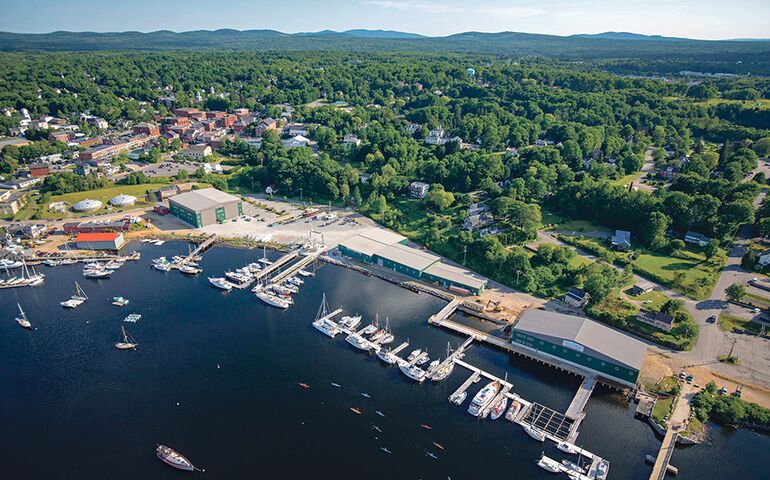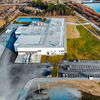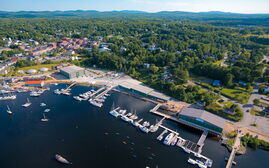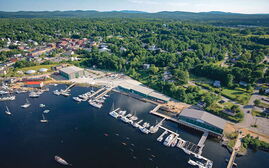Processing Your Payment
Please do not leave this page until complete. This can take a few moments.
- News
-
Editions
View Digital Editions
Biweekly Issues
- December 15, 2025
- December 1, 2025
- Nov. 17, 2025
- November 03, 2025
- October 20, 2025
- October 6, 2025
- + More
Special Editions
- Lists
- Viewpoints
-
Our Events
Event Info
Award Honorees
- Calendar
- Biz Marketplace
New technologies shape growth of ship-and-boatbuilding industry in past 25 years
 Photo / Billy Black
Front Street Shipyard is a privately held boatyard in Belfast. It builds, repairs and maintains a wide range of vessels.
Photo / Billy Black
Front Street Shipyard is a privately held boatyard in Belfast. It builds, repairs and maintains a wide range of vessels.
 File Photo / Jim Neuger
Portsmouth Naval Shipyard in Kittery has been steadily hiring to keep up with its workload refurbishing Navy vessels.
File Photo / Jim Neuger
Portsmouth Naval Shipyard in Kittery has been steadily hiring to keep up with its workload refurbishing Navy vessels.
Technological advances revolutionized the boatbuilding industry over the past 25 years.
Front Street Shipyard, Brooklin Boat Yard, Hodgdon Yachts, Lyman-Morse Boatbuilding, Hinckley Yachts and others are working with new lightweight, high-strength materials and digital tools, from computer numerical control machines to computer-aided drafting. They incorporate electronics that can allow the boat to be controlled from a single touchscreen. More recently, yards are looking at 3D printing for its potential to produce parts and molds.
Yet yards still value old-fashioned woodworking skills. And wooden boatbuilding remains a small but robust niche in a field dominated by fiberglass and composites.
The most recent recession resulted in hundreds of layoffs. Many builders began addressing the market’s unpredictability by diversifying. Hodgdon Yachts branched into building boats for government and military markets. Others turned their composites capabilities toward the production of non-marine components.
New partnerships created new opportunities. Front Street Shipyard in Belfast, founded in 2011, has seen unprecedented growth. Steve White, who owns Brooklin Boat Yard and is a partner in Front Street Shipyard, says Front Street was developed to meet customer demand for bigger boats over 80 feet. Indeed, the shipyard’s footprint on Belfast’s waterfront has expanded with additional boatbuilding space, including the 22,500-square-foot Building 6, which just opened.
“We always felt there was a demand for that kind of yard on the coast of Maine,” he says. White recalls the 1990s as a time when traditional wooden boatbuilding fell away, as composites took precedence. Since then, demand has increased for more sophistication in styles and systems. The digital revolution made design and construction far easier.
“In the early days, we were laying stuff out full-size on a loft floor, spending a couple of weeks on our hands and knees,” he says. “Computer design was a big step toward saving time and improving accuracy.”
Changes at shipyards supplying the Navy
Similar investments in Bath Iron Works and Portsmouth Naval Shipyard helped them maintain their shipbuilding prowess.
At Bath Iron Works, the 1990s was marked by dramatic cuts in the defense budget and a subsequent cutting of the workforce. Today, BIW’s workforce is roughly half the 1990 peak of 12,000 workers.
In 1995, BIW was acquired by General Dynamics, which invested $500 million in modernization initiatives. Soon after BIW received its first U.S. Navy order to build Arleigh Burke-class destroyers, followed by an order of three DDG 1000 destroyers. By 2014, BIW was looking to add 500 new employees and bring the workforce to 6,000. Over two decades, it has built more than 40 Arleigh Burke-class destroyers.
BIW currently has four DDG 51 destroyers under construction and two in backlog, with work expected to last into 2028. The shipyard continues to add workers, in many cases replacing those that have retired.
Portsmouth Naval Shipyard in Kittery is also scrambling to find 700 workers to meet a booming workload. That’s on top of the 1,400 hired over the past two years.
The shipyard is a major driver of Seacoast region’s economy.
Established in 1800 and the U.S. Navy’s oldest continuously operating shipyard, it was long a center for submarine design and construction. The last submarine was built there in 1969. In 1994, the shipyard was placed on an EPA Superfund site. The 2005 Base Realignment and Closure Commission placed the yard on a list for closures. But employees organized a “Save Our Shipyard” campaign, and the commission reversed its decision. Today the shipyard performs submarine overhaul, refueling and modernization work. As of 2017, the yard had 6,450 employees and a total economic impact of $751.8 million. Plans are in the works now to construct a multi-mission dry dock and other upgrades.
Mainebiz web partners
Related Content

The Giving Guide
The Giving Guide helps nonprofits have the opportunity to showcase and differentiate their organizations so that businesses better understand how they can contribute to a nonprofit’s mission and work.
Learn More
Work for ME
Work for ME is a workforce development tool to help Maine’s employers target Maine’s emerging workforce. Work for ME highlights each industry, its impact on Maine’s economy, the jobs available to entry-level workers, the training and education needed to get a career started.
Learn More
Groundbreaking Maine
Whether you’re a developer, financer, architect, or industry enthusiast, Groundbreaking Maine is crafted to be your go-to source for valuable insights in Maine’s real estate and construction community.
Learn more-
The Giving Guide
The Giving Guide helps nonprofits have the opportunity to showcase and differentiate their organizations so that businesses better understand how they can contribute to a nonprofit’s mission and work.
-
Work for ME
Work for ME is a workforce development tool to help Maine’s employers target Maine’s emerging workforce. Work for ME highlights each industry, its impact on Maine’s economy, the jobs available to entry-level workers, the training and education needed to get a career started.
-
Groundbreaking Maine
Whether you’re a developer, financer, architect, or industry enthusiast, Groundbreaking Maine is crafted to be your go-to source for valuable insights in Maine’s real estate and construction community.
ABOUT
NEW ENGLAND BUSINESS MEDIA SITES
No articles left
Get access now
In order to use this feature, we need some information from you. You can also login or register for a free account.
By clicking submit you are agreeing to our cookie usage and Privacy Policy
Already have an account? Login
Already have an account? Login
Want to create an account? Register
Get access now
In order to use this feature, we need some information from you. You can also login or register for a free account.
By clicking submit you are agreeing to our cookie usage and Privacy Policy
Already have an account? Login
Already have an account? Login
Want to create an account? Register











0 Comments